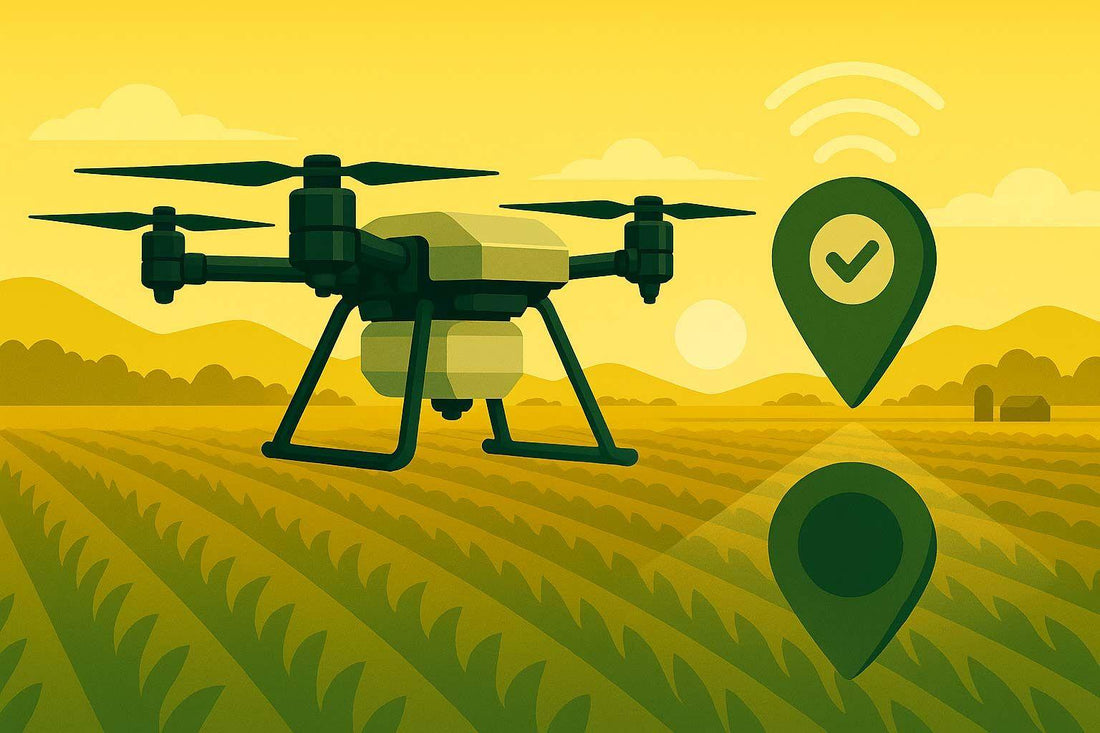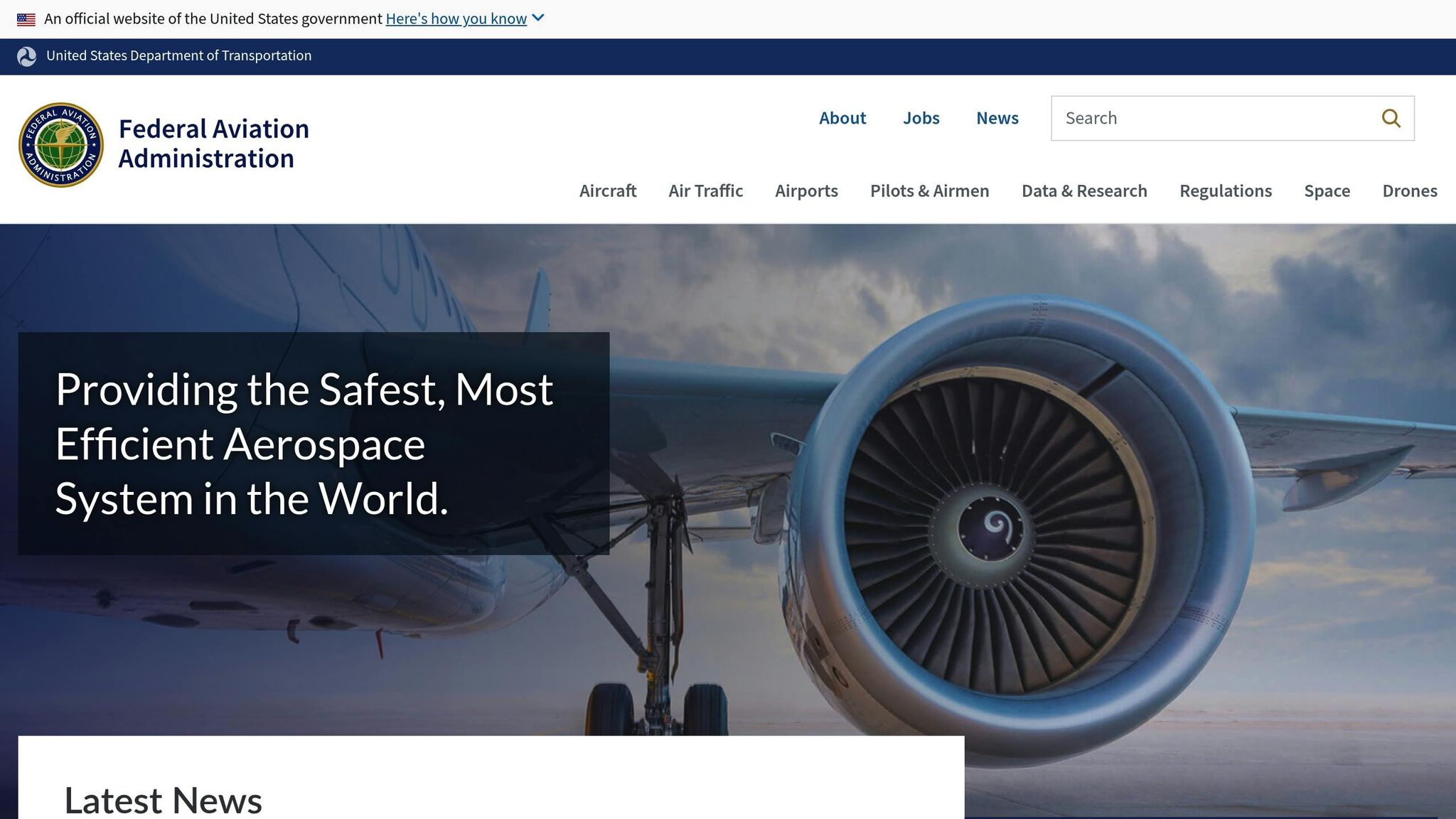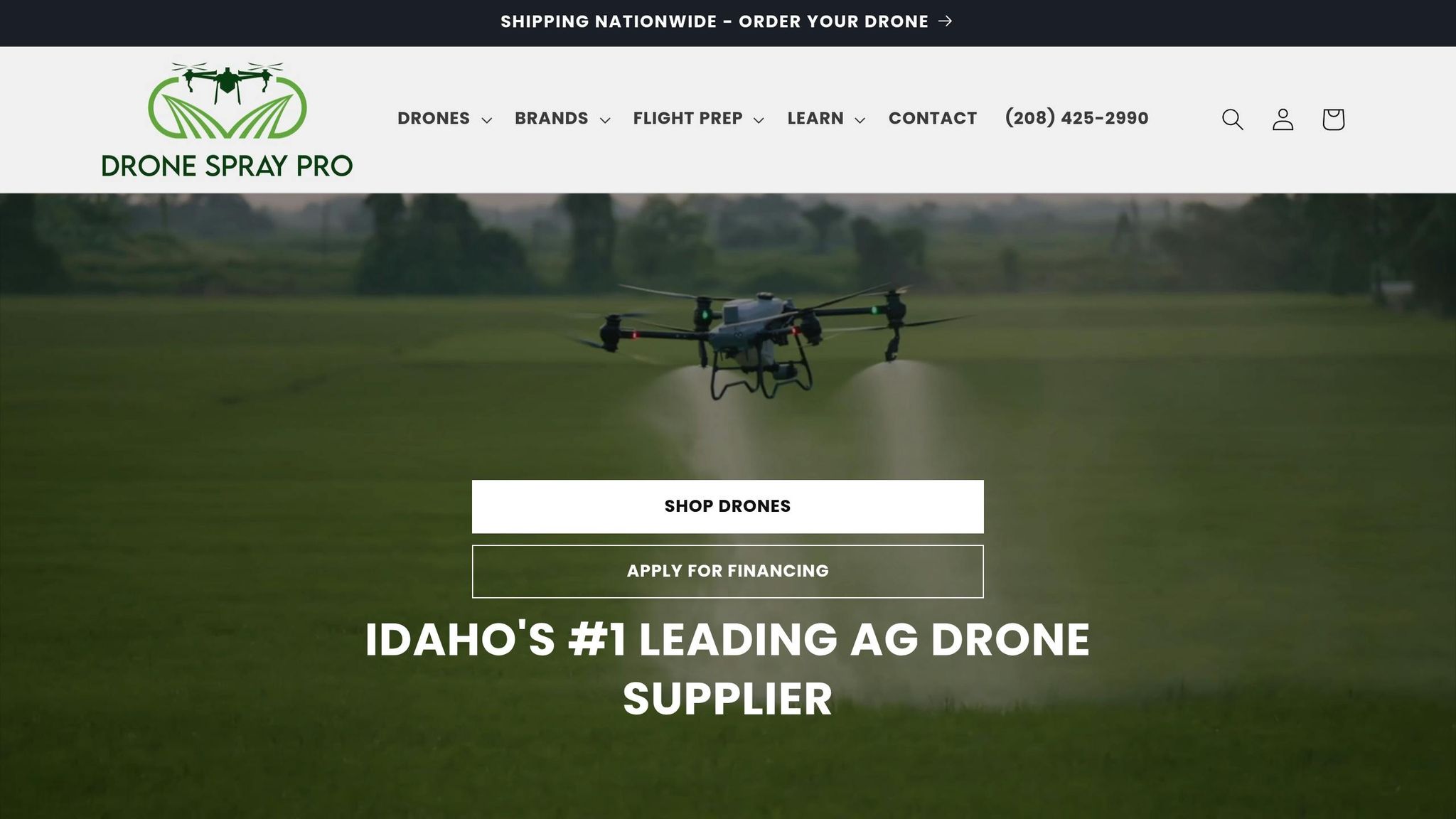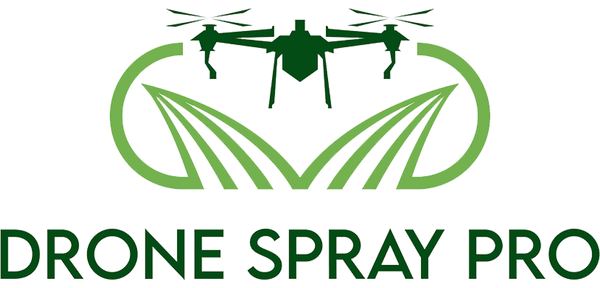
FAA Rules for GPS in Farming Drones
Share
The FAA regulates all drone operations in U.S. airspace, including GPS-equipped farming drones used on private property. Farmers must comply with drone registration, operational guidelines, and specific certifications to ensure safety and legality. GPS technology is critical for agricultural tasks like field mapping, precision spraying, and geofencing, but its use comes with strict FAA rules. Key takeaways:
- Drone Registration: Required for drones over 0.55 lbs; costs $5 and lasts three years.
- Remote Pilot Certificate: Mandatory under Part 107 for commercial drone use; involves passing a knowledge test.
- Part 137 Certification: Needed for chemical spraying operations; includes additional steps like exemptions and operator certificates.
- Remote ID Compliance: Drones must broadcast identification unless in designated areas.
- Operational Limits: Includes altitude (400 ft max), speed (100 mph max), and visual line-of-sight requirements.
- Advanced Operations: Waivers and exemptions (e.g., Section 44807) allow for larger drones or tasks beyond standard rules.
Farmers can streamline compliance by working with services like Drone Spray Pro, which provides licensing support, GPS-enabled drones, and training tailored to agricultural needs.
Here's What it Takes to Get Your Part 137 Certification
Main FAA Rules for GPS-Equipped Farming Drones

If you're working with GPS-equipped agricultural drones, it's essential to understand the FAA rules that apply. These regulations ensure drones are operated safely and legally. The FAA has outlined three main frameworks for farming drone operations, each with its own set of requirements.
Part 107: GPS-Equipped Small UAS
Part 107 applies to small UAS weighing under 55 pounds that are used commercially. This is the most common regulation for GPS-equipped farming drones in the U.S.
To operate under Part 107, you must have a Remote Pilot Certificate, be at least 16 years old, and pass a 150-minute aeronautical knowledge test with a minimum score of 70%. Key operational rules include keeping the drone within visual line of sight, flying only during daylight or twilight with proper lighting, and avoiding flights directly over people unless they are part of the operation. These rules can influence how drones are used for tasks like field mapping and crop monitoring.
If your farming operation is in controlled airspace, you'll need authorization through LAANC or another FAA-approved process. This is especially relevant for farms near airports, as controlled airspace often overlaps with rural areas.
For situations where Part 107 rules don’t meet your specific needs, you can apply for waivers by showing the FAA how you’ll maintain safety under your proposed conditions. The FAA typically processes these requests within 90 days, depending on their complexity.
Registration is mandatory for all Part 107 drones. As of September 16, 2023, drones requiring FAA registration must also broadcast Remote ID information unless operated in a FRIA (FAA-Recognized Identification Area). If you're using drones for spraying applications, additional guidance under Part 137 will apply.
Part 137: GPS-Equipped Agricultural Aircraft Operations
Part 137 regulates drones used for spraying substances like pesticides, fertilizers, and disinfectants. This rule defines agricultural operations as those involving economic poisons, soil treatment, plant nourishment, or pest control.
The FAA has simplified the process for obtaining Part 137 UAS certificates. First, confirm that your drone activities and the substances you plan to spray fall under Part 137 guidelines. For example, disinfectants for viruses are considered economic poisons under Section 137.3.
The compliance process involves several steps: registering your drone, applying for an exemption, and obtaining an Agricultural Aircraft Operator Certificate (AAOC). Keep in mind that you’ll need a Part 107 certificate before pursuing an AAOC. This adds another layer of certification rather than replacing existing requirements.
To apply, you’ll need to complete FAA Form 8710-3 and email it along with your exemption number to UAS137Certificates@faa.gov. Be prepared for a detailed evaluation process.
The requirements differ based on the drone's weight. If your drone weighs over 55 pounds, you’ll need to provide additional operational details. Missing or incomplete information can delay the approval process. For advanced operations restricted by standard regulations, Section 44807 may offer another option.
Section 44807: GPS-Equipped Exemption Operations
Section 44807 provides a case-by-case exemption for operations that fall outside standard regulations. This is particularly useful for farmers using drones over 55 pounds or conducting activities not allowed under Part 107.
According to the FAA:
“49 U.S.C. § 44807 grants the Secretary of Transportation the authority to use a risk-based approach to determine if certain unmanned aircraft systems may operate safely in the national airspace system (NAS) on a case-by-case basis. This grants UAS operators safe and legal entry into the NAS, thus improving safety. We anticipate this activity will result in significant economic benefits.”
This exemption allows operations that would otherwise be prohibited, offering more flexibility for farming applications. However, to obtain it, you’ll need to submit a detailed application showing your operations can be conducted safely. The FAA evaluates factors like the drone’s size, weight, speed, and capabilities before granting approval.
For example, Victor Lee & Associates Inc. successfully used the Section 44807 exemption to operate a Shotover U1 drone weighing 88 pounds. Their approval included conditions such as maintaining visual line of sight, using a visual observer, and adhering to an Air Traffic Organization (ATO) Certificate of Waiver or Authorization (COA).
For farmers needing to operate larger drones or perform advanced tasks, Section 44807 offers expanded possibilities. However, the application process is thorough, often requiring expert assistance to craft a compelling exemption request.
GPS Requirements and Operating Guidelines
The FAA has laid out essential frameworks, and precise GPS guidelines build on these to help ensure safe and efficient farming drone operations. If you're using agricultural drones, understanding these GPS requirements and operating rules is key to staying compliant with FAA regulations. These guidelines go beyond simple registration and licensing by detailing best practices for setting up, operating, and maintaining GPS-equipped drones for farming.
Drone Registration and GPS Setup
If your agricultural drone weighs more than 0.55 lb (250 g) - which most farming drones do - you’re required to register it with the FAA through the DroneZone online portal.
Here’s what you’ll need for registration:
| Information Required | Description |
|---|---|
| Physical and mailing address | If these differ from one another |
| Email address | For receiving registration updates |
| Phone number | Contact information |
| Make and model of your drone | Specific details about the manufacturer |
| Remote ID serial number | Provided by the manufacturer (if applicable) |
| Credit or debit card | To pay the $5 registration fee |
Registration costs $5 per drone and is valid for three years. Once registered, you must physically mark your drone with the FAA registration number before flying. This applies whether you’re using the drone for field mapping, crop monitoring, or spraying.
Additionally, drones must broadcast a Remote ID unless operating within a FAA-recognized identification area (FRIA). The FAA has extended the deadline for this requirement to March 16, 2024, giving operators time to upgrade their equipment.
For drones over 55 pounds, the registration process is more detailed. These larger drones may require additional documentation, such as Special Airworthiness Certificates or Section 44807 exemptions, before they can legally operate with GPS.
Always carry your registration certificate - either a digital or paper copy - while flying. Operating an unregistered drone can lead to serious penalties, both regulatory and criminal.
Once your drone is registered and GPS is properly configured, the next step is ensuring you operate within FAA-defined limits.
Operating Limits and GPS Compliance
FAA guidelines set strict operational parameters for farming drones equipped with GPS. Stay within the 400-foot altitude limit and a maximum speed of 100 mph. These restrictions are crucial for safe operations and can influence how you plan tasks like spraying or field mapping.
Even with GPS assistance, maintaining a visual line of sight (VLOS) is mandatory for all flights. Autonomous operations beyond your visual range require specific FAA waivers.
Geofencing is another critical factor. Your drone’s GPS must integrate with tools like LAANC (Low Altitude Authorization and Notification Capability) to ensure compliance when flying near controlled airspace. If you need access to restricted areas, you’ll have to request authorization through LAANC or submit a traditional airspace authorization request, which includes the GPS coordinates of your planned operation.
Weather can also affect GPS accuracy. Always check GPS signal strength during pre-flight inspections. Poor reception can lead to altitude violations, airspace breaches, or loss of positioning data, all of which are serious issues for commercial drone operations.
These operational limits not only ensure safety but also help optimize the effectiveness of your drone’s GPS for agricultural tasks.
GPS Guidelines for Agricultural Operations
For precision farming, accurate GPS calibration is essential. Your GPS system should achieve sub-meter accuracy to support tasks like field mapping, variable rate applications, and avoiding overlap during spraying. Many operators rely on RTK (Real-Time Kinematic) systems or similar technologies to achieve this level of precision.
Integration with farm management software is equally important. Your drone’s GPS should record flight paths, application rates, and coverage maps that can be imported into precision agriculture platforms. This data improves efficiency and serves as documentation for regulatory purposes.
If you’re conducting Part 137 spraying operations, GPS tracking becomes even more critical. Your system must log precise coordinates for each spray pass to track patterns, monitor drift, and ensure accurate application rates. This data is invaluable for post-flight analysis and regulatory reporting.
GPS also plays a key role in managing field boundaries. Program your GPS with accurate field limits, including buffer zones near water sources, organic farms, and other sensitive areas. This helps prevent accidental overspray and ensures compliance with environmental guidelines.
Keep in mind that GPS systems consume extra power, so plan for additional battery reserves to handle return-to-home functions or emergency landings.
Finally, regular maintenance and calibration of your GPS system are non-negotiable. Perform accuracy checks before each day of operation, update firmware as needed, and have backup navigation options ready in case of emergencies. Reliable GPS performance is not just a good habit - it’s a critical part of FAA compliance in agricultural drone operations.
sbb-itb-3b7eef7
Getting Licensed for GPS Spray Drones
If you’re planning to operate GPS-equipped agricultural drones, you’ll need the right FAA certifications. Commercial drone operations require either a Part 107 Remote Pilot Certificate or a Part 137 Agricultural Aircraft Operator Certificate, with additional waivers available for advanced uses beyond standard regulations.
Here’s a closer look at how to obtain the licensing necessary for both basic and advanced agricultural drone operations.
Part 107 Certification Steps
The Part 107 Remote Pilot Certificate is the first step for commercial drone operations, covering tasks like field mapping, crop monitoring, and other non-chemical agricultural applications. This certification is essential for most farming tasks involving GPS-enabled drones.
To qualify, you must be at least 16 years old, proficient in English, and physically and mentally fit to operate a drone safely.
Start by creating an IACRA (Integrated Airman Certification and Rating Application) profile to get your FAA Tracking Number (FTN). This FTN is required to register for the knowledge test, so complete this step early to avoid delays.
Next, schedule the Unmanned Aircraft General - Small (UAG) Knowledge Test, which costs $175 and includes 60 questions. You’ll need to score at least 70% to pass. The test covers topics like airspace regulations, weather, flight operations, and safety rules.
The FAA recommends 15-20 hours of preparation for the test. Focus on areas like airspace classifications, weather patterns, and GPS regulations that relate to farming operations. Study materials are available directly from the FAA, but many operators also find online courses helpful.
After passing the test, complete FAA Form 8710-13 through IACRA. You’ll need to provide your test results, personal details, and intended drone use. The FAA will then conduct a TSA background check, which typically takes a few weeks.
Once cleared, you can print a temporary Remote Pilot Certificate from IACRA. Carry this certificate - either digitally or as a paper copy - whenever you operate your drone. Your permanent certificate will arrive by mail within a few weeks.
To keep your Part 107 certificate valid, you’ll need to complete recurrent training every 24 months. This training ensures you stay up to date with any changes in regulations or safety practices.
Part 137 License for Aerial Spraying
If you plan to use your drone for spraying pesticides, herbicides, or other chemicals, you’ll need a Part 137 Agricultural Aircraft Operator Certificate (AAOC). This certification involves additional steps beyond the Part 107 requirements.
The FAA has streamlined the Part 137 process, eliminating the need to submit documents to local Flight Standards District Offices. The process now starts with submitting a petition for exemption, followed by the AAOC application.
Before applying, ensure your drone is registered. Then, submit your petition for exemption at least 120 days in advance. The petition should include the specific sections of 14 CFR you want to be exempted from, the relief you’re seeking, and an explanation of how your request aligns with public interest and safety. Submit this through the Federal Docket Management System or by mail.
Once your exemption is approved, you’ll need to provide the FAA with operational details, such as your legal name, contact information for the Chief Supervisor of Operations, the pilot in command’s certification details, and your drone’s make, model, and registration number.
Complete FAA Form 8710-3 and email it, along with your exemption number, to UAS137Certificates@faa.gov. Ensure the name on the form matches the exemption holder’s name exactly to avoid delays.
Agricultural operations under Part 137 include applying substances like pesticides, plant nutrients, or soil treatments. Even disinfectants for viruses are considered “economic poisons” under this certification. Double-check all documents before submission to avoid delays caused by incomplete information.
Waivers and Exemptions for Advanced Operations
Standard Part 107 rules require visual line of sight and restrict flying to daylight hours, but agricultural needs often demand greater flexibility. The FAA offers waivers and exemptions to allow for deviations from these regulations.
For operations requiring extended capabilities, such as night flights or beyond visual line of sight (BVLOS), you can apply for additional waivers. These waivers are especially valuable for large-scale agricultural tasks where standard limitations reduce efficiency.
For drones weighing 55 pounds or more, a Section 44807 exemption is mandatory, regardless of the operation. This exemption requires detailed documentation about the drone’s safety features and capabilities.
When applying for a Part 107 waiver, identify the specific regulation you need to bypass. The FAA requires a thorough safety explanation that justifies the waiver and demonstrates how it serves public interest without compromising safety. Submit your application through FAADroneZone, ensuring all documentation is complete.
The FAA typically processes waiver requests within 90 days, though more complex cases may take longer. If additional information is needed, respond promptly to avoid delays.
For operations outside the scope of Part 107 or Part 137, you may need to apply for a Certificate of Waiver or Authorization using FAA Form 7711-2. Send this form to 9-UAS-91.113Waivers@faa.gov for review.
The FAA continues to refine regulations for drones, including expanded BVLOS operations. While future changes may simplify the waiver process, current operations must adhere to the existing rules.
Drone Spray Pro offers licensing support and training to help you navigate these requirements. Their team can assist with Part 107 preparation, Part 137 applications, and waiver submissions, so you can focus on your agricultural operations.
How Drone Spray Pro Helps with FAA Compliance

Drone Spray Pro is committed to helping farmers navigate FAA regulations with ease. Their services are designed to cover every aspect of drone operations, from licensing to equipment selection and training. Based in Idaho, the team understands the unique challenges farmers face when incorporating drone technology into their work while staying compliant with regulatory standards.
What sets Drone Spray Pro apart is their comprehensive approach. They don’t just provide equipment - they offer full support, ensuring farmers are equipped with the knowledge and tools they need to operate drones confidently and within FAA guidelines. Here’s how they simplify licensing, training, and equipment selection.
FAA Licensing Help and Training
Navigating FAA certifications can be daunting, but Drone Spray Pro simplifies the process. They provide step-by-step guidance for both FAA Part 107 and Part 137 certifications, ensuring farmers meet all eligibility requirements.
For Part 107, they help farmers prepare for the Knowledge Test, covering essential topics like airspace rules, weather considerations, and FAA regulations specific to agriculture. This support ensures farmers not only pass the test but also understand how these rules apply to their daily operations. They assist with exam scheduling at FAA-approved centers and guide clients through submitting Form 8710-13 to secure their license.
For those needing Part 137 certification to operate drones for chemical spraying, Drone Spray Pro offers tailored assistance. They help with the complex application process, including submitting petitions and exemption requests, as well as compiling the necessary documentation for spray operations.
Their training goes beyond licensing. Farmers receive hands-on instruction in GPS-enabled drone operations, learning precision spraying techniques, field survey methods, and data analysis. These skills are crucial for leveraging GPS technology effectively while staying compliant with FAA standards.
Compliant Drone Models and Accessories
Drone Spray Pro doesn’t just stop at training - they also provide access to FAA-compliant drones and accessories. Their inventory includes agricultural drones from trusted brands like DJI Agras, Talos, ABZ Innovation, and EAVision. These drones are equipped with GPS capabilities and safety features essential for compliant operations.
Popular models include the DJI Agras T100, T25, T40, and T50, as well as the Talos T60X, ABZ L30, and EAVision J100. To enhance GPS accuracy, they offer RTK (Real-Time Kinematic) dongles, which provide centimeter-level precision - key for regulatory compliance and effective spraying.
Drone Spray Pro also stocks batteries, chargers, and other components designed to work seamlessly with their drone models. These accessories ensure uninterrupted operations while adhering to FAA safety and operational standards. Additionally, the drones come with built-in software features like spray logging and rate control, which simplify record-keeping for compliance purposes.
Ready-Made Drone Packages for Farmers
For farmers looking for a hassle-free start, Drone Spray Pro offers "Ready to Fly" packages. These bundles are pre-configured to meet FAA requirements, saving time and effort compared to assembling components individually.
Tailored for U.S. farming needs, these packages include everything necessary for immediate use. Options like the "ULTIMATE FLY ALL DAY DJI T-40 Package" and the "Talos T60X - Fly All Day Package" cater to various operational scales. Each package includes a drone, batteries for extended use, charging equipment, and RTK dongles for precise GPS functionality. The "Fly All Day" setups are particularly beneficial for large-scale operations, offering the capacity for continuous field coverage.
The packages also come with software configured specifically for agricultural applications, featuring tools for flight logging, spray rate documentation, and GPS tracking. This eliminates the need for farmers to handle complex software setups while ensuring compliance with FAA regulations.
To top it off, Drone Spray Pro includes custom training with every package. This ensures farmers can make the most of their drone technology while maintaining strict adherence to FAA guidelines. By combining compliant equipment with ongoing support, Drone Spray Pro offers a complete solution for farmers entering the world of agricultural drones.
Summary and Key Points
The FAA has set specific rules for GPS-equipped farming drones to ensure both safety and efficiency. Greg Pratt, an instructor at DARTdrones, highlights the importance of understanding these regulations:
It is paramount for drone operators in agriculture to be well-informed of these regulations to avoid penalties and to ensure the safety of their operations.
GPS technology has become essential for modern farming. It enables precision spraying, targeted fertilizer application, and detailed field mapping. With nearly 75% of farmers already using or planning to adopt smart agriculture drones, GPS capabilities are now a crucial part of agricultural aviation. This technology allows farmers to reduce chemical waste, lessen environmental impact, and achieve pinpoint accuracy in crop management.
FAA regulations provide a clear framework for safely operating drones in U.S. airspace. Key requirements include Part 107 certification for basic drone operations, Part 137 licensing for commercial spraying, and specific exemptions for specialized agricultural tasks.
Beyond regulatory compliance, GPS-equipped drones deliver significant operational advantages. For example, agricultural spray drones can cover 40-60 acres per hour, with flight times of 10-15 minutes per battery - making them highly efficient for large-scale farming.
Companies like Drone Spray Pro make it easier for farmers to adopt these tools. Their Idaho-based team, with firsthand farming experience, offers complete solutions, including FAA licensing support, GPS-enabled drones, RTK dongles for enhanced accuracy, and comprehensive training programs. As they put it:
As local Idaho farmers who use these drones ourselves, we'll help you get it right.
This practical expertise ensures farmers can navigate the complexities of advanced technology and regulatory requirements effectively.
FAQs
What’s the difference between Part 107 and Part 137 certifications for using farming drones with GPS?
The key distinction between Part 107 and Part 137 certifications lies in their specific applications and requirements for agricultural drone use. Part 107 is the standard certification for commercial drone pilots. It covers general drone operations such as mapping, surveying, and crop monitoring. However, it does not permit the spraying of chemicals.
On the other hand, Part 137 is a specialized certification designed for drone operators who need to spray chemicals like pesticides or fertilizers. This certification includes additional safety protocols and operational guidelines, similar to those required for traditional crop dusting. In the U.S., operating a drone for chemical spraying typically requires both Part 107 and Part 137 certifications.
For those navigating this process, companies like Drone Spray Pro offer support with FAA licensing, training, and setting up the necessary equipment to ensure compliance with these regulations.
What is the FAA’s Remote ID requirement for farming drones, and how can operators ensure compliance?
The FAA's Remote ID rule mandates that drones weighing 0.55 pounds (250 grams) or more must broadcast their identification and location details during flight. Beginning March 16, 2024, this regulation will cover most drones used in agricultural work.
To meet these requirements, operators need to:
- Register their drones with the FAA.
- Hold a Remote Pilot Certificate if using drones for commercial purposes.
- Ensure drones are equipped with Remote ID transmitters or use models that already have Remote ID built in.
Following these steps will help operators ensure their farming drones comply with FAA regulations, enabling safe and lawful use in agricultural operations.
How does GPS technology improve the performance of agricultural drones?
GPS technology is a game-changer for agricultural drones, providing accurate navigation and precise task execution. Equipped with advanced systems like RTK (Real-Time Kinematic) technology, drones can achieve centimeter-level accuracy. This precision is essential for tasks such as precision planting, targeted spraying, and efficient resource application.
With this level of accuracy, drones can cover fields more effectively, minimizing resource waste and improving crop yields. By leveraging GPS, farmers can streamline their operations, save valuable time, and make informed decisions based on data, ultimately enhancing productivity and efficiency in modern agriculture.
